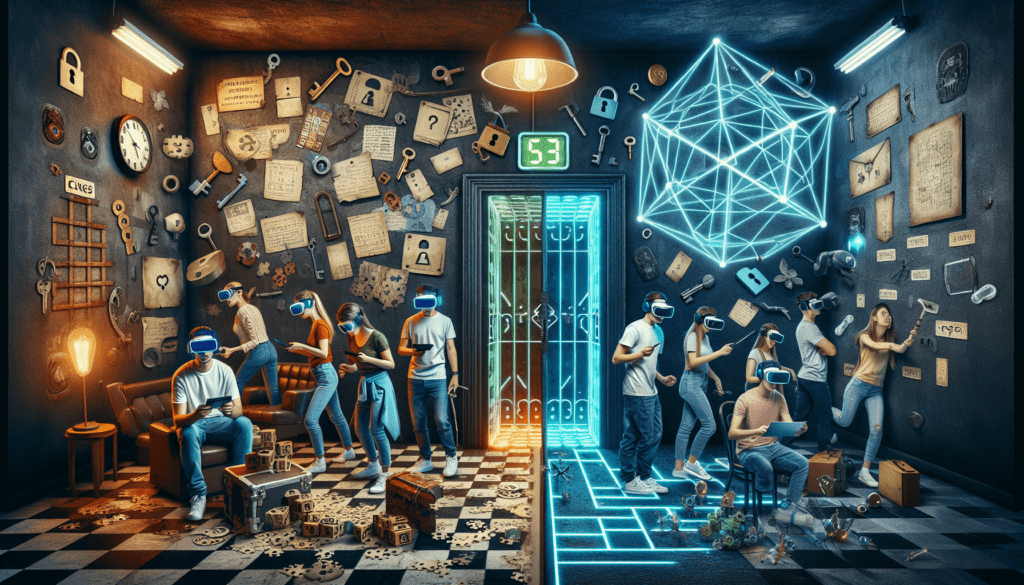Imagine a world where reality and imagination merge into a thrilling adventure. Picture yourself locked in a room, unraveling clues, solving puzzles, and working against the clock to escape before time runs out. This is the essence of an escape room, an immersive experience that has swept the globe in recent years. But what does the future hold for these captivating establishments? With advancements in technology and a growing demand for interactive entertainment, the possibilities are endless. So, fasten your seatbelts and get ready to embark on a journey that explores the exciting future of escape rooms.

Expansion of Virtual Reality in Escape Rooms
Virtual reality (VR) technology has made a significant impact on the escape room industry, revolutionizing the way people experience these immersive puzzle games. VR technology enhancements have played a crucial role in attracting more players and expanding the reach of escape rooms. By integrating VR into escape rooms, players are transported into virtual worlds that provide a heightened sense of realism and immersion.
With VR technology, escape room designers can create elaborate and intricate virtual environments that were previously unimaginable. Players can explore beautifully rendered settings, such as ancient tombs or futuristic space stations, and interact with objects and characters in ways that were not possible before. The level of detail and interactivity in VR escape rooms creates a truly immersive experience that engrosses players from start to finish.
In addition to the visual enhancements, VR technology also allows for the incorporation of realistic audio and haptic feedback, further enhancing the immersion. Players can hear the subtle sounds of their surroundings, adding to the overall atmosphere of the game. The sense of touch is also heightened through haptic feedback devices, which provide vibrations or physical sensations that simulate interactions with virtual objects.
Moreover, interactive and dynamic puzzles in VR escape rooms take the gameplay to a whole new level. Traditional escape rooms often rely on physical locks and mechanisms, but with VR, the possibilities are limitless. Players can manipulate virtual objects, solve intricate puzzles, and unlock hidden passages, all through intuitive hand gestures and movements. These interactive elements make the gameplay more engaging and challenging, creating a truly immersive and unforgettable experience.
Integration of Augmented Reality
Alongside the expansion of VR, escape rooms are also incorporating augmented reality (AR) technology to enhance the gameplay and introduce real-world interactions. AR overlays virtual elements onto the physical environment, blending the digital and real world together in a seamless manner.
AR technology integration provides escape room enthusiasts with new opportunities to solve puzzles and navigate through challenges. By using AR-enabled devices such as smartphones or specialized glasses, players can see virtual objects and clues superimposed onto their surroundings. This allows for a unique blend of digital and physical interactions, creating a dynamic and immersive gameplay experience.
AR in escape rooms also enhances puzzle solving by presenting information and clues in innovative ways. Players can scan their surroundings, revealing hidden messages or unlocking secret paths. The integration of AR technology introduces a new level of creativity and complexity to the puzzles, as players must decipher both the physical and virtual elements to progress through the game.
Gamification and Storytelling
Escape rooms have always thrived on the excitement of solving elaborate puzzles within a captivating narrative. To further engage players and create more immersive experiences, escape rooms are embracing gamification and storytelling elements.
Interactive narratives take center stage in modern escape rooms, allowing players to become fully immersed in a carefully crafted story. Players are no longer just solving puzzles; they become active participants in the unfolding narrative, influencing the course of events through their actions and decisions. This level of player agency enhances the overall experience and creates a deeper connection with the game world.
Branching storylines are another feature that amplifies the immersive nature of escape rooms. The choices made by players can lead to different outcomes and alternative paths, ensuring that each playthrough is unique. This adds replay value to the escape room experience, as players can explore different storylines and uncover new secrets with each visit.
Role-playing elements are also becoming increasingly popular in escape rooms. Players are given specific roles or characters to embody, each with unique abilities or knowledge. This adds an extra layer of depth to the gameplay, as players must work together, utilizing their individual strengths to overcome challenges. The inclusion of role-playing elements encourages teamwork, fosters communication, and elevates the overall enjoyment of the experience.
Collaborative and Competitive Experiences
In recent years, escape rooms have embraced the multiplayer aspect, allowing groups of friends, families, or colleagues to tackle challenges together. The introduction of multiplayer and team challenges has transformed the escape room experience, making it more social and interactive.
Multiplayer escape rooms facilitate collaboration and cooperation among players. Instead of solving puzzles individually, teams must work together, pooling their knowledge and skills to overcome obstacles. This cooperative gameplay fosters communication, teamwork, and problem-solving abilities, providing a unique bonding experience for participants.
Real-time leaderboards have also made their way into escape rooms, elevating the competitive aspect of the game. Teams can compete against each other, striving to complete the room in the shortest amount of time. Real-time updates on the progress of other teams create a sense of urgency and heightened excitement, adding an extra layer of challenge to the experience.
The collaborative and competitive nature of multiplayer escape rooms encourages social interaction and strengthens relationships. Whether it’s strengthening bonds with friends or improving teamwork within a corporate setting, these experiences promote camaraderie and create lasting memories.

Escape Rooms in Unconventional Settings
As escape rooms continue to evolve, they are breaking away from the traditional indoor settings and venturing into unconventional and unique locations. These innovative experiences breathe new life into the escape room concept, offering players a fresh twist on the familiar.
Outdoor escape experiences provide a thrilling departure from the confined indoor settings. From abandoned warehouses to forest mazes, outdoor escape rooms transport players to unique environments that add an extra layer of excitement and challenge. The incorporation of natural elements and the vastness of outdoor spaces create a sense of adventure and exploration, making outdoor escape experiences an adrenaline-pumping thrill.
Mobile and portable escape rooms have also gained popularity. These compact setups allow escape room experiences to be brought to various locations, such as events, festivals, or even private parties. Mobile escape rooms are designed to be easily transported and set up, offering flexibility and accessibility to a wider audience.
Pop-up escape room experiences take the concept of temporary installations to the next level. These escape rooms can appear in unexpected places for a limited time, providing an element of surprise and exclusivity. Pop-up escape rooms often leverage their unique locations, such as historical landmarks or iconic buildings, to enhance the immersion and create unforgettable experiences.
Integration with Other Entertainment Venues
Escape rooms are no longer confined to standalone locations. They are now being integrated with other entertainment venues to provide a diverse and all-encompassing experience.
Escape room cafes and bars offer a unique fusion of entertainment and hospitality. Patrons can indulge in food and drinks while enjoying the thrill of solving puzzles. These venues often have dedicated sections where the escape rooms are set up, allowing visitors to seamlessly transition from a dining or social setting to an immersive gaming experience.
Escape room theaters take the concept of storytelling to a grand scale. Instead of being confined to a single room, players are immersed in a larger, theatrical production that unfolds around them. The combination of live actors, elaborate sets, and interactive puzzles create an immersive and cinematic adventure that blurs the lines between reality and fiction.
Escape room cruise ships provide a novel spin on the traditional escape room experience. Onboard these ships, players can enjoy the excitement of solving puzzles while exploring picturesque destinations. The integration of escape rooms with the luxury and entertainment offerings of cruise ships creates a truly unique and unforgettable vacation experience.

Technological Advancements in Physical Props
While virtual and augmented reality have taken the escape room industry by storm, technological advancements in physical props are also shaping the future of these immersive experiences. These innovations not only add excitement and interactivity but also enhance the overall gameplay.
Smart and interactive props have become a staple in modern escape rooms. These props are equipped with sensors, lights, and sound effects that respond to player interactions. For example, a puzzle box may require specific input or sequences to unlock, with lights and sounds indicating progress. Smart props add another layer of intrigue to the puzzles, making the gameplay more dynamic and engaging.
The integration of sensors and the Internet of Things (IoT) technology has also revolutionized the way escape rooms operate. Sensors can detect player actions, triggering events or unlocking hidden compartments. The IoT allows for the seamless integration of various elements within the room, creating interconnected puzzles and immersive environments that respond to player inputs.
Automatic puzzle reset systems have made the gameplay experience more efficient and streamlined. Instead of manually resetting puzzles after each playthrough, escape rooms can utilize mechanisms that automatically reset the room to its initial state. This reduces downtime between groups and ensures that each team starts with a clean slate, ready to tackle the challenges ahead.
Customization and Personalization
To cater to a wide range of interests and preferences, escape rooms are embracing the concept of customization and personalization. These tailored experiences offer players a chance to immerse themselves in themes and settings that resonate with them personally.
Escape rooms are now incorporating a diverse range of themes, from historical events to popular culture references. By tailoring the narrative, puzzles, and aesthetics to specific themes, players can engage with a subject matter they are passionate about. This customization extends to the design of the room itself, with carefully curated props and decorations that enhance the immersion and authenticity of the experience.
Personalized puzzles and challenges add a unique touch to escape rooms, creating a memorable and individualized experience for each player. These puzzles can be designed to align with the player’s interests, skills, or knowledge. By tailoring the difficulty level and content of the puzzles, escape rooms can provide a challenging yet achievable experience, ensuring that players are fully engaged and motivated throughout the game.
Dynamic difficulty levels are another feature that enhances personalization in escape rooms. By adjusting the complexity of puzzles and challenges in real-time, escape rooms can cater to different skill levels and ensure that every player has a fulfilling experience. Dynamic difficulty levels allow both beginners and experienced players to enjoy the game at their own pace, without compromising on the excitement and sense of accomplishment.

Educational and Training Applications
Escape rooms have extended beyond entertainment purposes and have found their place in various educational and training environments. These applications harness the immersive and interactive nature of escape rooms to facilitate learning, team building, and skills development.
Corporate team building exercises often incorporate escape rooms as a means of fostering collaboration, communication, and problem-solving skills among employees. The immersive nature of escape rooms allows teams to work together, utilizing their unique strengths and skills to overcome challenges. Through the shared experience of navigating through a series of puzzles, employees develop a sense of camaraderie and a greater appreciation for each other’s contributions.
Educational institutions have also recognized the value of escape rooms in the classroom setting. Escape rooms can be designed around specific subjects or learning objectives, allowing students to apply their knowledge in a practical and engaging manner. By incorporating puzzles and challenges that align with the curriculum, escape rooms provide a hands-on learning experience that promotes critical thinking, creativity, and collaboration.
Skills development programs have embraced escape rooms as a means of honing various abilities. From problem-solving and decision-making to communication and time management, escape rooms provide a dynamic environment for individuals to practice and refine these skills. Through the immersive and challenging nature of escape rooms, participants can develop and strengthen their skills in a fun and engaging manner.
Incorporation of Artificial Intelligence
The integration of artificial intelligence (AI) in escape rooms takes the immersive experience to new heights, adding a layer of intelligence and adaptability to the gameplay.
AI-powered non-playable characters (NPCs) bring escape room narratives to life. These virtual characters can interact with players, providing guidance, clues, or hindrances throughout the game. By analyzing player actions and responses, AI-powered NPCs can adapt their behavior in real-time, presenting customized challenges and adding a sense of unpredictability to the gameplay.
Adaptive gameplay is another feature that AI brings to escape rooms. By analyzing player performance and behavior, AI algorithms can dynamically adjust the difficulty and complexity of the puzzles. This ensures that players are consistently engaged and challenged, without becoming frustrated or overwhelmed. Adaptive gameplay promotes a sense of progression and accomplishment, as the puzzles adapt to the player’s skill level.
Hint systems powered by AI provide players with assistance when they are stuck or struggling to progress. AI algorithms can analyze the player’s actions and offer contextual hints or nudges in the right direction. This allows players to maintain momentum and overcome obstacles without becoming frustrated or resorting to complete assistance. Hint systems powered by AI strike a balance between challenge and support, ensuring an enjoyable and rewarding experience for players.
In conclusion, the future of escape rooms is evolving rapidly, driven by technological advancements, innovation in storytelling, and the integration of AI. With the expansion of virtual reality and augmented reality, escape rooms offer an unprecedented level of immersion, where players can explore intricate virtual worlds and solve interactive puzzles with heightened realism. Gamification and storytelling elements further enhance the immersive experience, offering interactive narratives, branching storylines, and role-playing elements. The collaborative and competitive experiences in multiplayer and team challenges, along with the integration of escape rooms in unconventional settings, provide unique and thrilling adventure opportunities. Integration with other entertainment venues broadens the reach of escape rooms, combining dining, theater, or cruise experiences with puzzle-solving excitement. Technological advancements in physical props introduce smart and interactive elements, sensors, and automatic puzzle reset mechanisms. Customization and personalization cater to individual interests and preferences, with tailored themes, personalized puzzles, and dynamic difficulty levels. Escape rooms have also found applications beyond entertainment, serving as tools for education, training, and skills development in corporate, educational, and skill-building programs. Ultimately, the incorporation of artificial intelligence adds a layer of intelligence and adaptability, with AI-powered NPCs, adaptive gameplay, and hint systems taking the escape room experience to the next level. The future of escape rooms is bright, offering endless possibilities for immersive and thrilling adventures.

